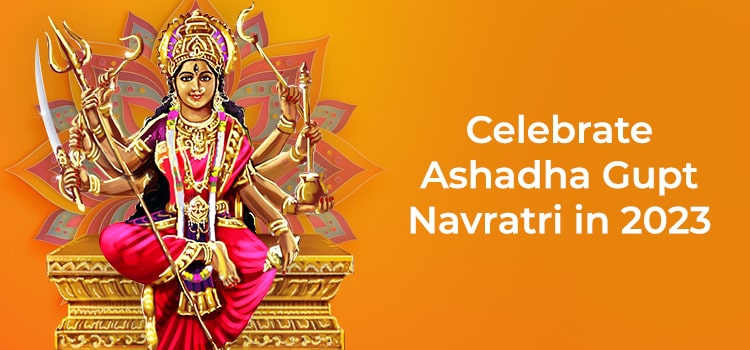Celebrate Ashadha Gupt Navratri in 2023
There are 4 Navratris in a year. Navratri is a Hindu festival dedicated to Goddess Durga. While Chaitra Navratri and Sharad Navratri are more popular and see grand celebrations in many parts of India, the other two Navratris – Ashadha and Magha - are not as popular.
Ashadha Navratri and Magha Navratris are also called Gupt Navratri, Varahi Navratri, Shakambari Navratri, Bhadrakali Navratri, Gayatri Navratri, etc. It falls on Ashadha Shukla Paksha (waxing lunar phase). The 9-day festival is mostly observed in north India. These 9 days and nights are very important for Shakti and Tantra sadhanas. Most of the Tantric rituals and sadhanas are shrouded in secrecy; hence it is called ‘Gupt,’ meaning ‘secret’. This Navratri is particularly important for those who worship Goddess Varahi, who is one of the Sapta Matrikas.
During the Vedic period, only a few sages and sadhaks knew about Gupt Navratri. The prevailing belief was that those who performed the Sadhana of Durga and the Dasa Mahavidyas (10 wisdom goddesses) during this time could gain great power and fulfill all their desires. This is why this Navratri is more popular among Tantrik practitioners.
Ashadha Navratri 2023 begins on June 19 and ends on June 27.

Significance of Ashadha Gupt Navratri
Worship of the Dasa Mahavidyas is believed to bring great merit during Ashadha Gupt Navratri. Devotees worship the Goddesses, Kali, Tara Devi, Tripurasundari, Bhuvaneshwari, Chinnamasta, Tripura Bhairavi, Dhumavati, Bagalamukhi, Matangi, and Kamala Devi, during this period. For those who do Bhairav sadhana, Shakti sadhana, and Mahakal sadhana, this is an ideal time to practice their sadhana and achieve siddhis (powers). During these 9 days, devotees worship various forms of Shakti, chant Mantras of Durga, and recite holy scriptures like Devi Mahatmya, Durga Saptashati, etc., to invoke divine blessings.
The Legend behind Ashadha Navratri
Sudharshan was the son of the king of Kosala. However, his father was deposed and killed due to a conspiracy and mutiny. He had to flee to the forest with his mother. They were given shelter by a sage. Once, while playing in the forest, the prince heard a sound, and he mimicked it several times for fun. The word was ‘Kleem,’ and it was the Beeja Mantra of Goddess Durga. Pleased by the boy’s chanting of the Mantra, Durga blessed him, and the prince eventually recovered his kingdom. This supposedly happened during Ashadha Navratri.
There is another legend about the power of this Navratri. Once, there was a woman whose husband led a wayward life and also forced his wife to take part in his immoral activities. One day, she complained to Rishi Shringi that she was not able to get Durga’s blessings due to her husband’s evil actions. She was also unable to observe vrat or perform Pooja at home. She ardently desired to worship Durga, and she sought the Rishi’s advice.
The rishi then told her about the Gupt Navratris, of which many people were not aware. He advised her to worship Durga during the Gupt Navratri period. Accordingly, the woman did severe penance during Gupt Navratri, and all her troubles vanished. She achieved peace of mind and prosperity. Her husband also mended his ways. It was all due to Durga's blessings.
Dos and Don’ts during Ashadha Navratri
Those who intend to do Pooja and Sadhana during Ashadha Navratri have to follow certain dos and don’ts. Let us see what they are:
The devotee should not wear any leather items.
One should avoid anger, desire, lust, envy, jealousy, etc., completely.
One should not cut one’s hair or nails during this time.
Nobody in the family should perform Mundan Sanskar.
Do not wear black-colored garments.
Do not sleep during the daytime.
Old or sick people, pregnant women, and small kids should not observe a strict vrat.
Ashadha Navratri Rituals
Devotees observe a strict fast and perform sadhana to gain occult powers during Gupt Navratri. Food is limited to one sattvik meal in a day. Partial fasting is observed by those who have any health problems. Fruits are allowed. Devotees offer prayers at dawn and dusk. Those who wish to attain siddhis and Moksha do meditation.
Devotees should sit on an Asana or seat of Durva or Kusha grass and light a diya using cow ghee. A single wick or 9 wicks have to be lit. One can offer red hibiscus flowers to the goddess. Chant prayers and Mantras of the Goddess with a mala of Rudraksha or red sandalwood beads. Worship Goddess Varahi and chant Mantras of Varahi. Read Devi Mahatmyam, Durga Saptashati, and Shrimad Devi Bhagavatam.
One should take the Sankalp for the 9-day fast. Worship Durga in the morning and evening after doing Ghatasthapana on Pratipada. Observe fast on Ashtami or Navami and worship young girls who are symbols of the goddess. But one should not discuss these rituals with others on Gupt Navratri.
Varahi Mantra
Chanting Varahi Mantra during Ashadha Navratri is said to bring great merit and many benefits.
Om Varahi Sarvati Mam Raksa raksa Durge Hum Phat Swaha
Om Mahishadhwajayai Vidmahe
Dandahastayai Dhimahi
Tanno Varahi Prachodayat
Worshipping Goddess Varahi on Ashadha Navratri brings blessings like material and spiritual growth, good health, protection, and prosperity. She bestows victory over enemies and courage and helps one to control one’s vices.



















